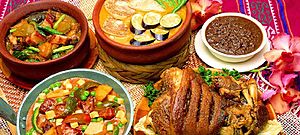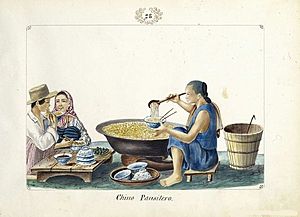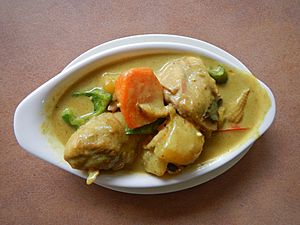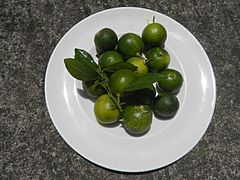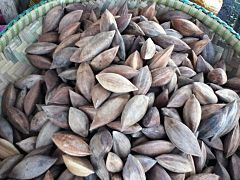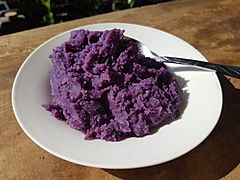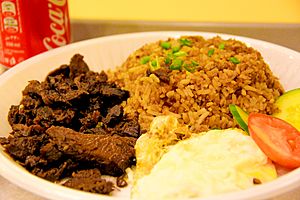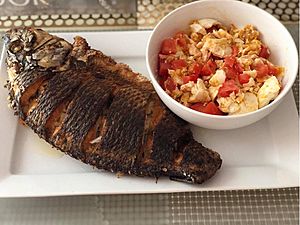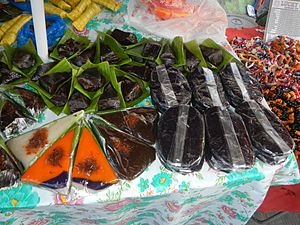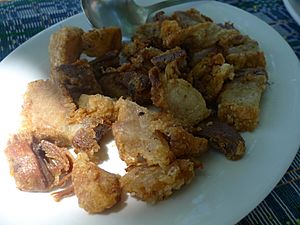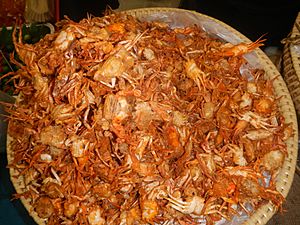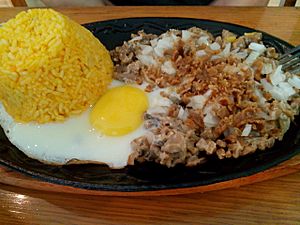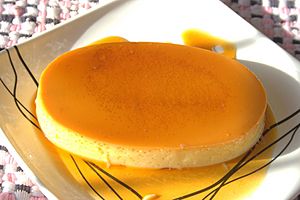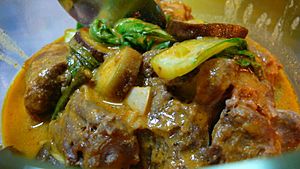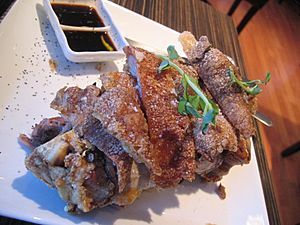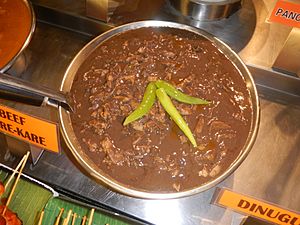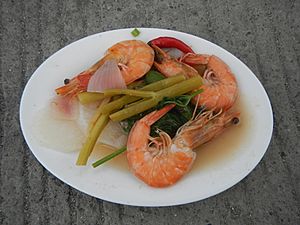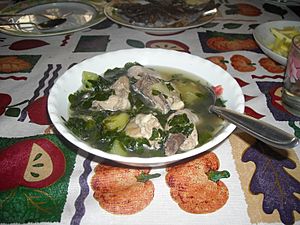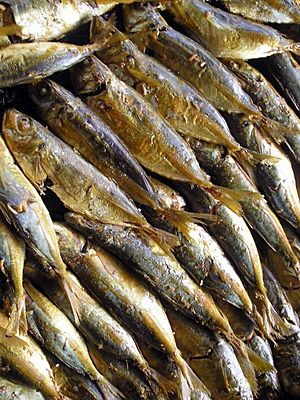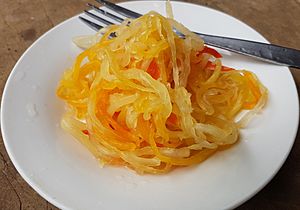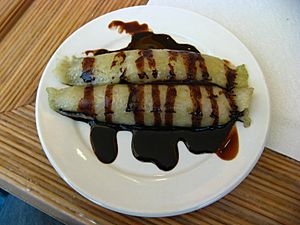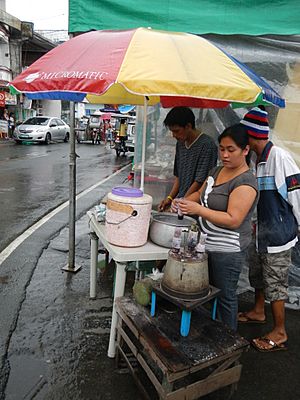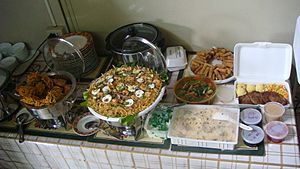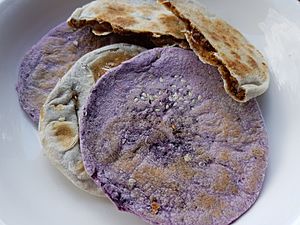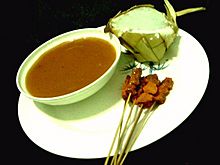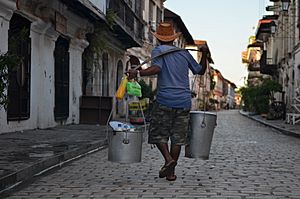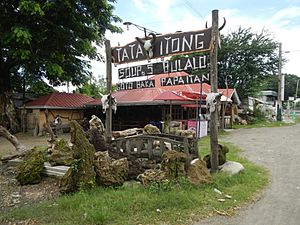Filipino cuisine facts for kids
Filipino cuisine is the delicious food from over a hundred different groups of people across the Philippines. Most of the popular Filipino dishes come from the cooking traditions of groups like the Ilocano, Kapampangan, Tagalog, and Visayan people. Filipino food has changed over many centuries. It started with local (mostly Austronesian) cooking styles, then got influences from Chinese, Spanish, and American foods. These influences mixed with local ingredients to create the unique flavors Filipinos love today.
Filipino dishes can be very simple, like fried salted fish and rice. They can also be more complex, like rich stews or noodle dishes. Some popular foods include: lechón (a whole roasted pig), longganisa (Filipino sausage), tapa (cured beef), adobo (a stew with vinegar and soy sauce), kare-kare (oxtail and vegetables in peanut sauce), sinigang (meat or seafood in a sour soup), pancit (noodles), and lumpia (spring rolls). Many food experts say Filipino cuisine is special because it blends "East meets West" flavors.
Contents
How Filipino Food Changed Over Time
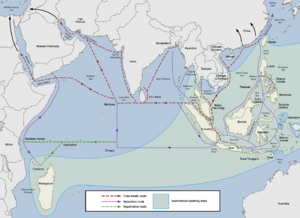
The first people in the Philippines, the Negritos, were hunter-gatherers. They ate wild plants, seafood, and game.
Around 6,000 years ago, seafaring Austronesians arrived. Most Filipinos today are their descendants. They brought new ways to farm and raise animals, along with different foods. Rice was very important and a sign of wealth. Many rice dishes were used in special ceremonies.
Spanish Rule and New Flavors
Spanish rule brought big changes to Filipino food. The Manila galleon trade network connected the Philippines with Mexico and China.
This trade brought two main cooking influences: Chinese and Mexican.
Many Chinese merchants came to the Philippines. They brought noodle dishes like pancit and noodle soups. They also introduced soy sauce (toyo), tofu (tokwa), eggrolls (lumpia), and fried rice (sinangag). Restaurants called panciterias became popular, serving noodle meals.
The galleon trade also connected Manila with Mexico. This brought many new crops from the Americas, like maize (corn), chili peppers, tomatoes, potatoes, peanuts, and chocolate. Mexicans also shared Spanish cooking methods, such as making sausages (longganisa) and baking bread. In return, the Philippines sent rice, sugarcane, coconuts, and mangoes to the Americas.
Indian and Japanese Food Ideas
Filipino food also shows some Indian influences. Dishes like bibingka and puto (rice cakes) might be similar to Indian puttu. The popular kare-kare stew might have come from Indian soldiers who needed to make curry during the British occupation of Manila (1762-1764). They used local ingredients like annatto and peanuts to create a curry-like sauce.
The famous cold dessert, Halo-halo (meaning "mixed-mixed"), got its start from Japanese Filipinos before World War II. It's similar to the Japanese kakigōri dessert. The first versions were simple, with sweetened mung beans, crushed ice, milk, and sugar. Over time, more Filipino ingredients were added, like ube (purple yam), coconut strips, and flan.
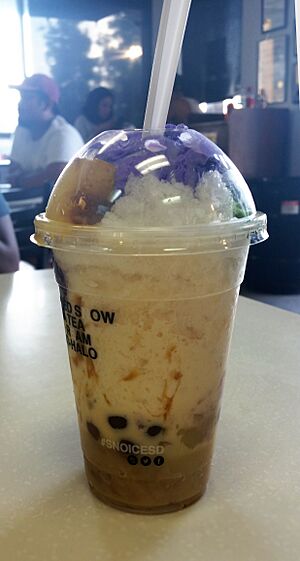
Odong, a noodle soup from the Visayas and Mindanao, is named after the round flour noodles used. These noodles are similar to Japanese udon. This dish came from the large Japanese community in the Davao Region and Visayas in the early 1900s.

American Influence
After the Spanish-American War in 1899, the United States took control of the Philippines. American soldiers brought foods like hot dogs, hamburgers, fried chicken, and ice cream. They also introduced easy-to-prepare foods like spam, corned beef, and instant coffee.
Today, Filipino cooking keeps changing as new methods and ingredients arrive. You can find traditional dishes alongside popular international foods and fast food.
What Makes Filipino Food Special?
Mixing Flavors
Filipino cooking often mixes sweet (tamis), sour (asim), and salty (alat) tastes. In some regions like Bicol, spicy (anghang) is also a key flavor.
Filipino food often pairs sweet with salty. For example, champorado (a sweet chocolate rice porridge) is eaten with tuyo (salted, sun-dried fish). Green mangoes, which are sour, are dipped in salt or shrimp paste. Cheese is also used in sweet cakes and even ice cream.
Cooking and Eating Styles
Traditionally, cooking and eating in the Philippines is a relaxed family event. Food is usually served all at once, not in separate courses.
Eating with Hands
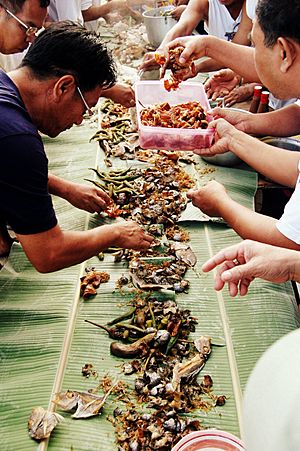
Filipinos usually don't use chopsticks. The traditional way to eat, especially dry dishes, is with your hands. This is called kamayan. You take a bite of the main dish, then eat rice pressed together with your fingers. While less common in cities, kamayan is still enjoyed during outdoor trips, beach vacations, and town festivals.
Kamayan is also part of a "boodle fight". This is a dining style started by the Philippine Army. Food is spread out on banana leaves on a table, and everyone eats together with their hands. However, using spoons and forks is still very common.
During Spanish rule, Filipinos started using spoons and forks. They didn't use knives much because Spain limited them. Filipinos use the side of the spoon to "cut" food.
Local Ingredients
Filipino cuisine uses many unique local ingredients. Kalamansi is a small citrus fruit that adds a sour taste to dishes. Another fruit, tabon-tabon, was used by early Filipinos to keep Kinilaw (raw seafood dishes) fresh.
The Philippines also grows different nuts, like the pili nut. The Philippines is the only known exporter of edible pili nuts. They are often eaten as a snack or added to desserts for a creamy texture.
Vinegar is a very common ingredient. Adobo is popular because it's simple to make and can be stored for days, even tasting better over time. Tinapa (smoked fish) and tuyo (sun-dried fish) can last for weeks without refrigeration.
Meals and Snacks
Filipinos usually eat three main meals a day: almusal (breakfast), tanghalían (lunch), and hapunan (dinner). They also have morning and afternoon snacks called merienda.
Breakfast (Almusal)
A traditional Filipino breakfast might include pandesal (small bread rolls), kesong puti (white cheese), or champorado (chocolate rice porridge). Many breakfasts are "silog" meals, which means sinangag (garlic fried rice) with a fried egg and meat. Common meats include tapa (cured beef), longganisa (sausage), or tocino (sweet cured pork). Coffee, especially strong kapeng barako, is also popular.
Filipinos often combine words to describe breakfast meals. For example, tapsilog means tapa, sinangág (fried rice), and itlog (egg). Other silog variations include tocilog (with tocino) and longsilog (with longganisa).
Lunch (Tanghalian)
A typical Filipino lunch includes one or two main dishes with rice, and sometimes soup. Rice is eaten with almost everything. Because the Philippines is a tropical country, cold water, juices, or soft drinks are often served with meals.
Dinner (Hapunan)
Dinner is still a main meal, but it's often smaller than in other countries.
Snacks (Merienda)
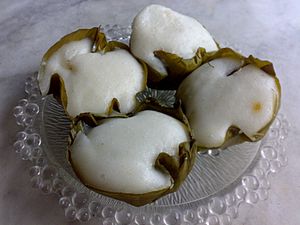
Merienda is a light meal or snack, usually in the afternoon. If it's eaten close to dinner, it's called merienda cena and might replace dinner.
Filipinos enjoy kapé (coffee) with breads and pastries like pandesal, ensaymada (buttery bread with cheese and sugar), and hopia (pastries with bean paste). Traditional sticky rice pastries called kakanín are also popular, such as kutsinta, sapin-sapin, and suman.
Savory merienda dishes include pancit canton (stir-fried noodles), palabok (rice noodles with shrimp sauce), and dinuguan (pork blood stew), often served with puto (steamed rice cakes).
Chinese-influenced snacks like Dim sum and dumplings are also popular. Street foods like squid balls and fish balls are often eaten with soy sauce and calamondin juice.
Snacks with Drinks (Pulutan)
Pulutan are like "finger foods." They were originally eaten with alcoholic drinks but are now also served as appetizers or even main dishes, like sisig.
Some deep-fried pulutan include chicharon (pork rinds) and crispy pig intestines. Grilled pulutan include isaw (grilled chicken or pig intestines), pork barbecue (skewered pork), and betamax (grilled solidified pork or chicken blood). Sisig is a popular pulutan made from chopped pig's cheek, ears, and liver.
Smaller snacks like mani (peanuts) are sold by street vendors. Kropeck (fish crackers) are also common.
Tokwa't baboy is fried tofu with boiled pork, served with a garlic-soy sauce-vinegar dip. It's also a side dish for pancit luglog or pancit palabok.
Special Occasion Foods
For celebrations, people prepare more special dishes. Tables are often full of delicious foods that take hours to make. Lechon (whole roasted pig) is usually the main dish at Filipino parties. It's served with a special lechon sauce, often made from the roasted pig's liver. Other festive dishes include hamonado (honey-cured meat), relleno (stuffed chicken or fish), paella, and menudo.
Sweet treats for parties include leche flan (caramel custard), ube (purple yam) desserts, sapin-sapin, and sorbetes (ice creams).
Christmas Eve, called Noche Buena, is a very important feast. The main foods are Christmas ham and Edam cheese (queso de bola). Puto bumbong, a purple sticky rice cake steamed in bamboo tubes, is popular during Christmas.
Lumpiang sariwa (fresh spring rolls) are often made for parties. They have a soft wrapper filled with vegetables and meat, served with a sweet peanut and garlic sauce. Ukoy are shrimp patties made with shredded papaya and fried. Both are often served together at Filipino parties. Lumpiang sariwa has Chinese origins.
Types of Filipino Food
Filipino food varies a lot from one family to another, as each has its own traditions.
Main Foods
Like in most Asian countries, rice is the main food in the Philippines. It's usually steamed and served with meat, fish, and vegetable dishes. Leftover rice is often fried with garlic to make sinangag, a common breakfast food. Rice flour is used for sweets and cakes. Sticky rice with cocoa, called champorado, is also a common dish.
Coconuts are used everywhere. Coconut meat is in desserts, coconut milk (kakang gata) in sauces, and coconut oil for frying. Dishes like laing and sinilihan (known as Bicol Express) from the Bicol region use a lot of coconut milk.
Many fruits and vegetables are used in cooking. Plantains (saba), kalamansi, guavas, mangoes, and pineapples give a tropical flavor. Common vegetables include water spinach (kangkong), Chinese cabbage, eggplants (talong), and yard-long beans (sitaw). The combination of tomatoes (kamatis), garlic (bawang), and onions (sibuyas) is in many dishes.
Common meats include chicken, pork, beef, and fish. Seafood is very popular. Common catches are tilapia, milkfish (bangus), shrimp (hipon), crabs (alimango), and squid (pusit). Seaweeds are also eaten.
Fish is often salted, pan-fried, or deep-fried, and eaten with rice and vegetables. It can also be cooked in a sour broth like sinigang, or roasted over charcoal (inihaw). Other ways to prepare fish include escabeche (sweet and sour) or kinilaw (raw seafood marinated in vinegar, like ceviche). Fish can be preserved by smoking (tinapa) or sun-drying (tuyo).
Food is often served with different dipping sauces. Fried food is dipped in vinegar with onions, or soy sauce with Kalamansi juice. Patis (fish sauce) is mixed with kalamansi for seafood or added to stews. Fish sauce, fish paste (bagoong), and shrimp paste (bagoong alamang) are common condiments.
Popular Main Dishes
Adobo is one of the most famous Filipino dishes. It usually has pork or chicken, cooked in a sauce of vinegar, oil, garlic, bay leaf, peppercorns, and soy sauce. Bistek, or "Filipino beef steak," is thinly sliced beef marinated in soy sauce and calamansi, then fried with onions.
Some well-known stews are kare-kare and dinuguan. Kare-kare has oxtail or ox tripe cooked with vegetables in a peanut sauce, usually served with bagoong (fermented shrimp paste). Dinuguan is a stew made of pig's blood, insides, and meat, cooked with vinegar and chili peppers.
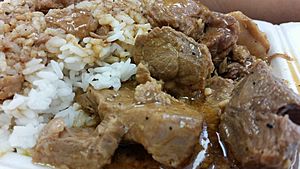
Paksiw refers to different stews cooked in vinegar. Paksiw na isda uses fish, while paksiw na baboy uses pork, often with sugar and banana blossoms. Paksiw na lechon is made from lechon meat with liver spread to thicken the sauce.
In crispy pata, pork knuckles are marinated in garlic vinegar and deep-fried until crispy. Lechon manok is the Filipino version of rotisserie chicken, roasted over charcoal and served with a special sauce.
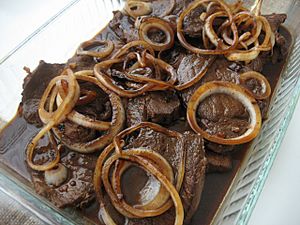
Mechado, kaldereta, and afritada are Spanish-influenced dishes cooked in tomato sauce. Mechado uses beef with pork fat inserted. Kaldereta can be beef or goat, cooked with vegetables in tomato sauce. Afritada is similar but usually uses chicken and pork. Puchero is a sweeter stew with beef and plantains in tomato sauce.
Filipinos also eat tocino (sweetened cured meat) and longganisa (sweet or spicy sausage).
Filipino soups are usually hearty and stew-like, with large pieces of meat and vegetables or noodles. They are meant to be filling and are often eaten with rice. Sinigang is a very popular sour soup, often made with pork, beef, chicken, or seafood, and made sour with tamarind. Tinola is a chicken soup with green papaya and moringa leaves in a ginger broth. Nilagang baka is a beef stew with cabbage.

Noodle dishes are generally called pancit. Pancit recipes use noodles, vegetables, and meat or shrimp. Some, like mami, are noodle soups, while others are "dry" like chow mein. Filipino spaghetti is a sweet version of spaghetti bolognese, sometimes with banana ketchup and hot dog slices.
Rice porridges are also popular. Arroz caldo is a chicken and ginger rice porridge. Goto is a version of arroz caldo with ox tripe. Champorado is a sweet chocolate rice porridge, often eaten for breakfast with dried fish.
Other rice dishes include arroz a la valenciana, a Filipino version of Spanish paella. Bringhe is a local rice dish similar to paella but uses sticky rice, coconut milk, and turmeric.
For vegetarians, there's dinengdeng, a dish with moringa leaves and bittermelon. Pinakbet is stewed vegetables flavored with bagoong. Kinilaw is a seafood salad with raw seafood marinated in vinegar, similar to Peruvian ceviche.
Common Cooking Methods
Here are some common Filipino cooking terms:
- Adobo (inadobo) – Cooked in vinegar, oil, garlic, and soy sauce.
- Afritada – Braised in tomato sauce.
- Babad (binabad) – To marinate.
- Bagoong (binagoongan) – Cooked with fermented fish or shrimp paste (bagoong).
- Bibingka – Baked cakes, usually made from sticky rice.
- Daing (dinaing) – Salted and dried, usually fish.
- Guinataan (sa gata) – Cooked with coconut milk.
- Guisa (guisado) – Sautéed with garlic, onions, or tomatoes.
- Hamonado – Marinated or cooked in a sweet pineapple sauce.
- Halo-Halo – A cold dessert with crushed ice, milk, and various sweet ingredients.
- Ihaw (inihaw) – Grilled over coal.
- Kinilaw – Raw fish or seafood marinated in vinegar or calamansi juice.
- Lechon (nilechon) – Roasted on a spit (like a whole pig).
- Lumpia – Savory food wrapped in an edible wrapper.
- Nilaga – Boiled or braised.
- Paksiw (pinaksiw) – Cooked in vinegar.
- Pancit – Noodle dishes, often from Chinese Filipino cooking.
- Pinakbet – Vegetables cooked with bagoong.
- Prito (pinirito) – Fried or deep-fried.
- Puto – Steamed cakes, usually made from sticky rice.
- Relleno – Stuffed.
- Sarza (sarciado) – Cooked with a thick sauce.
- Sinangag – Garlic fried rice.
- Sisig – A traditional Filipino dish, often served with beer, made from different parts of a pig.
- Sigang (sinigang) – Boiled in a sour broth, usually with tamarind.
- Tapa or Tinapa – Dried and smoked.
- Torta – In the northern Philippines, an omelette-like dish cooked with eggs.
Breads and Pastries
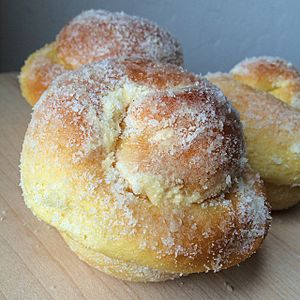
In a typical Filipino bakery, you'll find pandesal, monay, and ensaymada. Pandesal (bread of salt) is a common breakfast bread, often eaten with coffee. Ensaymada is a pastry with butter, sugar, and shredded cheese, popular during Christmas. It can also have fillings like ube (purple yam). Pan de coco is a sweet roll filled with shredded coconut and molasses.
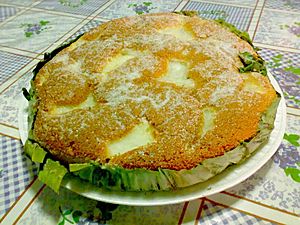
Other pastries include pianono (chiffon roll with fillings) and brazo de mercedes (meringue roll with custard). Leche flan is a caramel custard, a heavier version of Spanish flan, and a must-have at celebrations.

Egg pie with its rich custard filling is a bakery favorite. Buko pie is made with young coconut meat. Mamon is a soft chiffon cake. Crema de fruta is a fancy sponge cake with layers of cream, custard, candied fruit, and gelatin.
Stuffed pastries like empanadas (meat-filled turnovers) and siopao (local version of Chinese baozi) are common. Buchi are deep-fried dough balls filled with sweet mung bean paste. Hopia are mooncake-like pastries with different fillings.
Side Dishes
Itlog na pula (red eggs) are salted duck eggs, often served with diced tomatoes. Atchara is a side dish of pickled papaya strips, often eaten with fried dishes.
Nata de coco is a chewy, jelly-like food made from fermented coconut water. Kesong puti is a soft white cheese made from carabao milk. Grated coconut (niyog) is usually served with sweet rice desserts.
Drinks
Cold Drinks and Shakes


Cold drinks are popular because of the tropical weather. Fruit shakes are common, made with crushed ice, milk, and fruits like mango, avocado, or pineapple.
Other cold drinks include sago't gulaman, a flavored ice drink with sago and agar gelatin; fresh buko (coconut juice) straight from a young coconut; and kalamansi juice, sweetened with honey or sugar.
Brewed Drinks
Filipinos love coffee. Kapeng barako from Batangas is a very strong coffee. Civet coffee is also known. Tea is becoming more popular. Salabat, or ginger tea, is brewed from ginger root and often served when it's cold or when someone is sick.
Tsokolate is Filipino hot chocolate, traditionally made from tablea (pure cacao tablets). It's popular during the Christmas season.
Desserts

Many Filipino desserts use rice and coconuts. Bibingka is a hot rice cake topped with butter, cheese, or salted duck eggs. Biko is a sticky rice sweet with sugar, butter, and coconut milk. Bitsu-bitsu are fried rice flour donuts coated in sugar syrup.
Puto are sweet steamed rice cakes in different sizes and colors. Sapin-sapin are three-layered, tri-colored sweets made with rice flour and purple yam. Palitaw are rice patties with sesame seeds, sugar, and coconut.
For cold desserts, halo-halo is a favorite. It has shaved ice, milk, and sugar, with ingredients like coconut, ube halaya (mashed purple yam), leche flan, and fruit. Sorbetes (ice cream) is popular, with some local versions using coconut milk. Ice candy are frozen snacks made from fruit juice or local ingredients like ube. Mango float is a dessert with Graham crackers, mangoes, cream, and milk, layered and chilled.
Regional Specialties
The Philippines has many different groups of people, so there are many different regional cuisines.
Luzon Cuisine
Ilocanos in the Ilocos Region eat a lot of boiled vegetables and freshwater fish. They love dishes flavored with bagoong (fermented fish paste). Their pinakbet is made with bagoong monamon (fermented anchovy paste).
The Igorot people prefer roasted meats like carabao (water buffalo), goat, and venison.
Baguio is known for its fresh produce like strawberries. It's also known for sundot-kulangot, a sticky sweet made from glutinous rice flour and molasses.
Isabela is famous for Pancit Cabagan and rice cakes like Inatata & Binallay. Cagayan is known for its Carabao Milk Candy.
Kapampangan cuisine uses all the local produce. Specialties include longganisa (sweet and spicy sausages), calderetang kambing (goat stew), and tocino. Kapampangans also make sisig from pork cheeks and offal.
The food of the Tagalog people varies by province. Bulacan is known for Chicharrón (pork rinds) and steamed rice cakes. It's a center for desserts like kutsinta, sapin-sapin, and suman. San Miguel is famous for its carabao milk candy pastillas de leche. Cainta in Rizal is known for its Filipino rice cakes and puddings. Antipolo is known for its suman and cashew products. Laguna is known for buko pie (coconut pie). Batangas is famous for its special coffee, kapeng barako. Quezon, especially Lucban, is known for Lucban longganisa, pancit habhab, and hardinera.
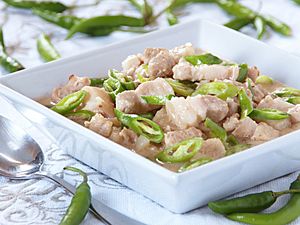
The Bicol is known for its spicy dishes. The most famous Bicolano dish is the very spicy Bicol Express. The region is also known for natong (laing or pinangat), which is pork or fish stew in taro leaves.
Visayan Cuisine
In Visayas, batuan (a sour fruit) is used to make dishes sour. Tultul, a type of rock salt from Guimaras, is sprinkled on rice.
Bacolod is known for inasal, a local version of chicken barbecue cooked with annatto seeds for a reddish color. The city is also famous for sweets like piaya, napoleones, and pinasugbo (caramelized banana).
Leyte is home to Binagol, Carabao Milk Pastillas, Suman Latik, and Moron (food). Taclobanon cuisine uses a lot of grated coconut and coconut milk. Humba (a sweet pork stew) is said to be from Leyte. Because Leyte is by the sea, many seafood dishes are found there.
Aklan is known for inubarang manok (chicken cooked with banana pith) and binakol na manok (chicken cooked in coconut water). A unique local food is tamilok (shipworm), which is eaten raw or dipped in vinegar.
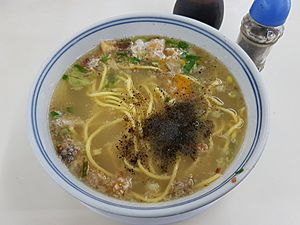
Iloilo is the home of batchoy, a noodle soup with fresh egg noodles, slow-cooked broth, beef, pork, and shrimp paste. Toppings include fried garlic, crushed chicharon, and pork intestines. Pancit Molo is another noodle dish from Iloilo, similar to wonton soup. Iloilo is also famous for its kadios (pigeon pea)-based soups like KBL (kadios baboy langka) and KMU (kadios manok ubad).
Roxas City is known as the "Seafood Capital of the Philippines" due to its many seafood dishes like mussels, oysters, and scallops.
Cebu is known for its unique lechón, which has crispy skin and juicy meat flavored with spices. Cebu is also known for dried mangoes and caramel tarts.
In Bohol, kalamay (a sticky rice sweet) is popular. In Palawan, crocodile meat is made into tocinos.
Mindanaoan Cuisine
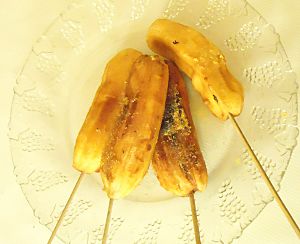
In Mindanao, Sulu, and Tawi-Tawi, dishes are rich with spices common in Southeast Asia: turmeric, coriander, lemon grass, cumin, and chilies. The cuisine of the indigenous groups in Mindanao and the Sulu archipelago is similar to the spicy Malay cuisine of Malaysia and Brunei, as well as Indonesian and Thai food.
Well-known Mindanao and Sulu dishes include Satti (satay) and ginataang manok (chicken cooked in spiced coconut milk). In Muslim areas of Mindanao, pork is rarely eaten. Lamb, mutton, goat, and beef are the main red meats.
Rendang, a spicy beef curry from Sumatra, and dishes like biryani and kulma are served on special occasions.
Piyanggang manok is a Tausug dish of barbecued chicken marinated in spices and served with coconut milk infused with toasted coconut.
Chupá Culo and Curacha con Gatâ are Zamboangueño dishes made with shells and crab cooked in coconut milk.
Popular crops include cassava root, sweet potatoes, and yams.
Sambal, a spicy sauce with belacan, tamarind, and chilies, is a popular base for many dishes in the region.
Palapa is a special condiment from Maranao and Maguindanaon cuisines. It's made from shredded coconut, a type of green onion, ginger, chilies, salt, pepper, and turmeric.
Another popular dish is tiyula itum, a dark broth of beef or chicken flavored with ginger, chili, turmeric, and toasted coconut.
Lamaw (Buko salad) is a mix of young coconut, its juice, milk or orange juice, with ice.
Other Foods
Street Food and Snacks

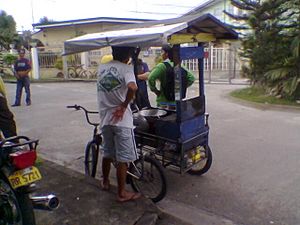
Besides pastries, there are heartier snacks for merienda that can also be appetizers. Siomai is the local version of Chinese shaomai.
Lumpia are spring rolls, either fresh or fried. Fresh lumpia (lumpiang sariwa) is often made for special events. Fried lumpia (lumpiang shanghai) is usually filled with ground pork and vegetables, served with sweet and sour sauce. Lumpia is also sold frozen.
There are many unique street foods in the Philippines. Some are skewered on sticks like kebabs. Banana-cue is a whole banana or plantain skewered, rolled in brown sugar, and pan-fried. Kamote-cue is similar, but with peeled sweet potato. Fish balls and squid balls are pan-fried, skewered, and dipped in sweet or savory sauce. These are often sold by street vendors.
Turon is a kind of lumpia with a wrapper filled with sliced plantain and sometimes jackfruit, then fried and sprinkled with sugar.
Taho is a warm treat made of soft beancurd, dark caramel syrup (arnibal), and tapioca pearls. Street vendors often sell it by calling out "taho!" Taho comes from the Chinese snack douhua.
Iskrambol (from "scramble") is an iced treat similar to a sorbet. Shaved ice is mixed with flavors and often topped with chocolate syrup. It's eaten by mixing the contents and drinking with a large straw.
Street food with eggs includes kwek-kwek (hard-boiled quail eggs dipped in orange batter and deep-fried) and tokneneng (larger versions using chicken or duck eggs). Another Filipino egg snack is balut, a boiled fertilized duck or chicken egg with a developing embryo. It's usually eaten with vinegar and salt. Penoy is a hard-boiled unfertilized duck egg.
Okoy (or ukoy) is another deep-fried street food with batter, bean sprouts, shredded pumpkin, and small shrimps. It's dipped in vinegar and chili.
Other street foods include isaw (grilled intestines), betamax (grilled dried chicken blood cubes), Adidas (grilled chicken feet), and proven (deep-fried chicken proventriculus). Sweet potato fries are also called "Pinoy fries." Many street foods are found near schools and universities.
Fast food burger stands like Burger Machine and Angel's Burger are open 24/7 across the country.
Unique Dishes
Some unique dishes in the Filipino diet include camaro (field crickets cooked in soy sauce, salt, and vinegar), popular in Pampanga. Papaitan is a stew made of goat or beef insides flavored with bile, which gives it a bitter (pait) taste.
Filipino Food Around the World
Filipino-American Cuisine
Filipino-American cuisine started in the United States with Filipino immigrants in the early 1900s. They created a unique cooking style that used local ingredients and fit American tastes.
Many Filipino restaurants and catering services are found in "Little Manilas" across the United States, especially in cities like Los Angeles and New York City. These places introduced popular Filipino dishes like inihaw na liempo, lumpiang shanghai, adobo, and kare-kare to the U.S.
Some modern Filipino-American restaurants have changed traditional dishes for American tastes. They use different ingredients, cooking methods, and presentations. Restaurants like Bad Saint in Washington D.C. and Maharlika in New York are praised for their special dishes. Cendrillion, opened in 1995, was one of the first to make Filipino cuisine popular with new ideas like rabbit adobo or crème brûlée with ginger and lemongrass.
Tom Cunanan, a famous Filipino-American chef, opened Pogiboy, which mixes American and Filipino food. They serve sinigang-flavored fried chicken and longganisa and tocino-filled hamburgers. Señor Sisig in San Francisco combines Filipino and Mexican food, serving dishes like burritos and nachos with Filipino flavors. This helps introduce Filipino cuisine to Americans by mixing it with more familiar foods. Some of these restaurants also offer the kamayan feast, where diners eat a variety of Filipino dishes with their hands.
Popular Filipino fast-food chains like Jollibee have also opened in the United States. Jollibee is known for its American-influenced items like fried chicken and hamburgers, but also serves Filipino dishes like pancit palabok, halo-halo, and peach-mango pie. Other chains like Chowking (Filipino-Chinese fast food) and Red Ribbon (bakery) also have locations in the U.S.
Ube (purple yam), a traditional Filipino ingredient, has become very popular in the United States. It's used in many American desserts like waffles, cupcakes, and doughnuts. Ube is also a flavor for beer in some breweries and is sold in grocery stores like Trader Joe's in ice cream, pancake mix, and cookies.
Images for kids
See also
 In Spanish: Gastronomía de Filipinas para niños
In Spanish: Gastronomía de Filipinas para niños


